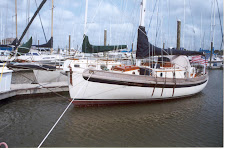Sunday, September 26, 2010
Lightning
A wood masted vessel requires a different approach to lightning protection. If all the rigging is synthetic a heavy gauge cooper wire installed from masthead to deck, like the Strike Shield system, could provide a ground path that the aluminum mast would typically offer but I really don't want anymore weight in the mast. I had also thought about installing long chain plates like the Pardeyes in order to extend the stainless steel shroud ground path all the way to the water line. However, I don't want to buy another set of chainplates; I already have the standard length ones. So, if at the the dock I'll hope that lightning finds a taller mast than mine and if offshore and lightning moves into the neighborhood I'll clamp a battery cable to each shrould and throw the other end over the side. That probably won't save the electronics but it might prevent the mast from burning down.
Sunday, September 5, 2010
Mast, Boom Gaff and Standing Rigging
I have made several changes to the mast furniture design. The spars are nearing completion so it is decision time.
Just to recap the mast is Sitka Spruce and measures 45 ft end to end or 39 feet above the main deck. The diameter at the base is 6 3/4 inches. At the 32 foot mark the diameter is 6 inches and from there up the mast tapers down to 3 inches. The headstay, cap shrouds and runners will be synthetic Dynema from Coligo but the forestay and lower shrouds will be 5/16 inch stainless on 5/8ths inch rigging screws on bronze chain plates.
The Dynema headstay will be bridled to the mast against an aft thumb 6 feet below the top of the mast at the 39 foot mark. Since all head sails will be free flying the headstay's job is confined to mast support. And its only companion at this altitude will be the spinnaker halyard block on a strop.
The Dyneema 9mm cap shroud terminates 2 and and a half feet further down at 36.6 feet. Since the jib halyard block, the upper peak halyard block and the topsail leader line all attach at this same height, a bronze mast band would serve best for an attachment point. The mast band ears for the peak halyard blocks should be horizontal not vertical so that the blocks don't get in a strain and rest comfortably regardless of gaff twist.
Next at 35 feet the two running backstays and the lower peak halyard block will attach to a mast band with three ears. The ears for the back stays will be vertical but peak halyard block ear horizontal.
Three feet further down at the 32.3 foot level the forestay is pinned to the mast band, the throat halyard block is attached to a crane and the staysail halyard block is attached on a strop over the mast band.
The single set of spreaders, the port and starboard topping lift blocks and the forestay share the 28.5 foot level on the mast. To save the weight of another chunk of bronze the forestay will be bridled and the topping lifts will be on cheek blocks.
The gooseneck is 9 ft 4 inch above the keel step or 40 inches above the main deck or 22 inches above the house top.
Make sense?
Just to recap the mast is Sitka Spruce and measures 45 ft end to end or 39 feet above the main deck. The diameter at the base is 6 3/4 inches. At the 32 foot mark the diameter is 6 inches and from there up the mast tapers down to 3 inches. The headstay, cap shrouds and runners will be synthetic Dynema from Coligo but the forestay and lower shrouds will be 5/16 inch stainless on 5/8ths inch rigging screws on bronze chain plates.
The Dynema headstay will be bridled to the mast against an aft thumb 6 feet below the top of the mast at the 39 foot mark. Since all head sails will be free flying the headstay's job is confined to mast support. And its only companion at this altitude will be the spinnaker halyard block on a strop.
The Dyneema 9mm cap shroud terminates 2 and and a half feet further down at 36.6 feet. Since the jib halyard block, the upper peak halyard block and the topsail leader line all attach at this same height, a bronze mast band would serve best for an attachment point. The mast band ears for the peak halyard blocks should be horizontal not vertical so that the blocks don't get in a strain and rest comfortably regardless of gaff twist.
Next at 35 feet the two running backstays and the lower peak halyard block will attach to a mast band with three ears. The ears for the back stays will be vertical but peak halyard block ear horizontal.
Three feet further down at the 32.3 foot level the forestay is pinned to the mast band, the throat halyard block is attached to a crane and the staysail halyard block is attached on a strop over the mast band.
The single set of spreaders, the port and starboard topping lift blocks and the forestay share the 28.5 foot level on the mast. To save the weight of another chunk of bronze the forestay will be bridled and the topping lifts will be on cheek blocks.
The gooseneck is 9 ft 4 inch above the keel step or 40 inches above the main deck or 22 inches above the house top.
Make sense?
Subscribe to:
Posts (Atom)
